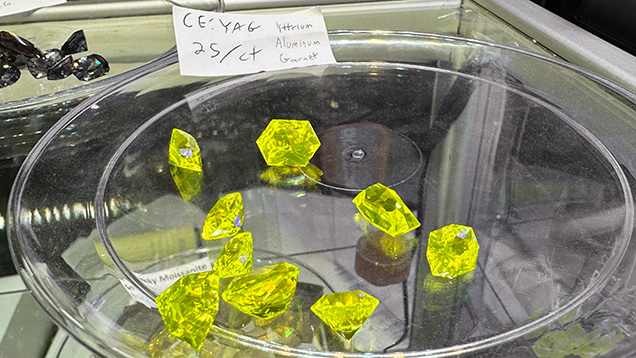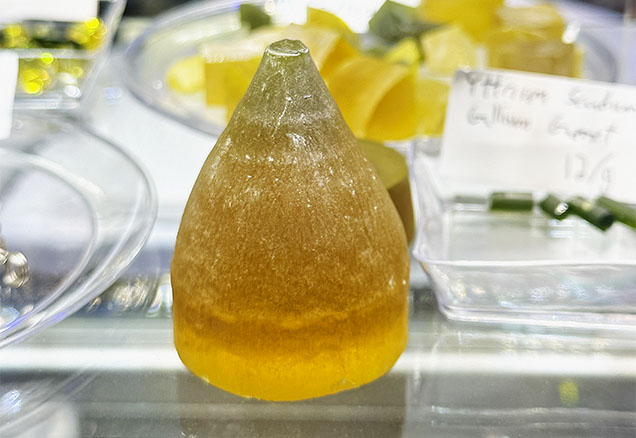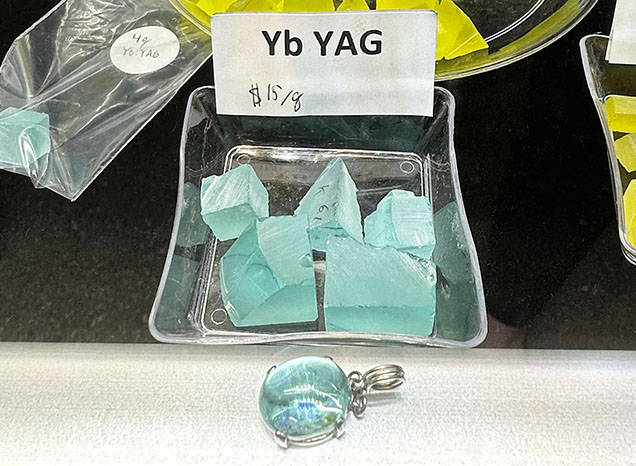Luminescent Synthetic Garnet-Like Crystals

At the 22nd Street show, the author spoke with Tim Challener of Turtle’s Hoard (Raleigh, North Carolina), who was selling some unique rough and faceted luminescent synthetic garnet-like crystals, which he referred to as “lumogarnets.” After 12 years in the gem business, Turtle’s Hoard began selling only laboratory-made materials in March 2022. Challener noted that their best-selling gemstone is Ce:LuAG, lutetium aluminum garnet (Lu3Al5O12) doped with cerium. This material was introduced to the optics industry in the late 1990s and acts as a scintillator, a fluorescent crystal that absorbs high-energy radiation such as X-rays or gamma rays and reemits them as lower-energy visible light that is much easier to detect. LuAG is closely related to YAG electronically and both have the same garnet structure, yielding a gem with similarly excellent optical and gem properties (see figure 1).
Yttrium aluminum garnet, known as YAG (Y3Al5O12), a lab-grown crystal that crystallizes in the cubic garnet structure, was one of the most popular diamond simulants from the 1960s to the mid-1970s due to its relatively good hardness (about 8.25 on the Mohs scale) and brilliance. Cartier’s replica of the 69.42 ct Taylor-Burton diamond famously used YAG. Gadolinium gallium garnet, known as GGG (Gd3Ga5O12), was the next garnet-like material to be used as a diamond simulant. GGG is slightly more brilliant and dispersive than YAG but scratches fairly easily due to its lower hardness (about 6.5 to 7.5 on the Mohs scale).
Most of these garnet-like crystals are doped with various rare earth elements such as neodymium, erbium, cerium, and ytterbium. These dopants not only increase the materials’ value in the optics industry but also yield the variously colored synthetic garnet-like crystals seen in the gem and jewelry industry today.

These synthetic garnet-like crystals are most commonly produced by the Czochralski method, also known as the pulling method. In this melt process, the boule (a cylindrical synthetic crystal produced by a melt process) grows from a thin cylindrical seed crystal that is dipped into a melt of the desired garnet composition. The seed is rotated and then lifted very slowly at a controlled rate, allowing the melt to crystallize onto it. The material produced is extremely pure, with few inclusions or none at all. However, the material is not actually made for the gem and jewelry industry; rather, those in the industry can only purchase some of the less-perfect material and off-cuts of the boules to facet and sell (figure 2).
Challener explained, “They are lab-created, but each one has its own history beyond its use as a gem. And while there have been conflicting messages about whether some lab-grown stones, particularly lab-grown diamonds, are truly eco-friendly, the materials we work with are an inevitable byproduct of necessary crystal growth. Our modern lives rely on these materials being grown—we can’t have cell phones without lithium niobate or modern PET scanners without scintillators—so there isn’t really any additional waste associated with them.”

Turtle’s Hoard offered a variety of “lumogarnets,” including rough and faceted luminescent yellow and yellowish green cerium-doped GAGG (gadolinium aluminum gallium garnet, Gd3Al2Ga3O12), cerium-doped LuAG, and cerium-doped YAG (see again figure 1). In addition, they displayed rough grayish purple neodymium-doped YAG, rough and cut greenish blue ytterbium-doped YAG (figure 3), rough pinkish orange erbium-doped YAG, and rough and faceted green chromium-doped YAG, a green stone with strong red fluorescence showing simultaneous flashes of green and red based on lighting, dubbed “Christmas garnet.” Although synthetic and possessing a garnet-like structure, YAG, GGG, LuAG, and GAGG are not synthetic garnet, since they lack the chemistry of any garnets known in nature.
.jpg)


